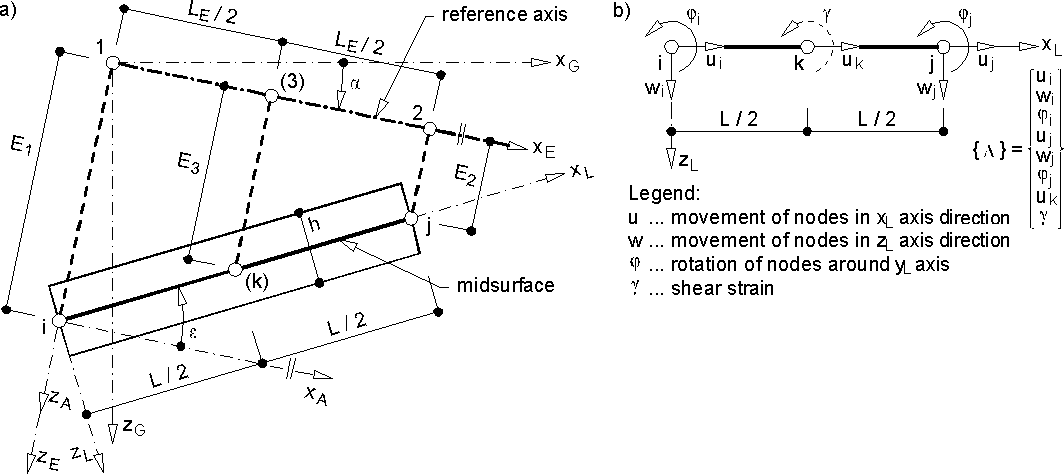
engineering & technology publications
ISSN 1759-3433
PROCEEDINGS OF THE SIXTH INTERNATIONAL CONFERENCE ON COMPUTATIONAL STRUCTURES TECHNOLOGY
Time-dependent and Materially Non-linear Analysis of Concrete Structures
Department of Structural Mechanics, Faculty of Civil Engineering, Brno University of Technology, Czech Republic
Reinforced and prestressed concrete can be assumed to be materials for which the non-linear material models of concrete, reinforcement and tendons are valid, as well as the distinct characteristics of concrete in compression and tension, the change of stress in tendons as a result of structure deformation, etc. The necessity of carrying out material non-linear analyses of building structures is due to these factors. The behaviour of structures in the serviceability state is among other things affected by the rheological effects and also by the construction procedure.
The paper presents a method and computational program for the time-dependent and material non-linear analysis of concrete plane frame structures. The computational method is based on a layered approach and uses material models, which are based on the theory of plasticity and fracture mechanics, and rheological effects, which are based on the viskoelastic theory. For the analysis, the ANSYS computational system with the user BEAM element is used.
For solving materially non-linear problems encountered while modelling the load-bearing elements of structures, three basic approaches can be generally applied: the integral, layered and cell approach. The computational method, which is found in the paper, is based on the layered approach.
When solving materially non-linear problems, it is necessary to define a model for the material characteristics and demonstrate their non-linear character, as well as possible unloading, reloading etc. Generally, two basic types of material models can be used: material models based on plasticity and material models based on the principles of fracture mechanics. As above mention for analysis with user beam element is possible used both groups of material models.
Rheological properties of concrete (creep and shrinkage) are dependent on the duration time of the loading effect. The viskoelastic theory is used for description of rheological effects. In order to respect rheological effects in analysing the construction, it is necessary to apply the method of time-discretization combined with the finite element method. In this method the state of stress is assumed to be constant in the selected time intervals. The changes are taking place only at the discrete time nodes. Here the stress and displacement fields are determined using the finite element method.
For solving time-dependent and materially non-linear analysis of concrete
structures the ANSYS computational system with the user BEAM element is used.
The user BEAM element, which is derived in [1], is a straight, three-node, 2D (plane
XZ) finite beam element with eccentrically connected end nodes ![]() referential to
the nodes of the finite element method
referential to
the nodes of the finite element method ![]() , which are placed on the reference axis,
Figure 110.1. The interior node
, which are placed on the reference axis,
Figure 110.1. The interior node ![]() lies at the centre of the beam element. The element
allows the continuous deformation compatibility. This means that in cases where
more than one beam element is placed between two nodes on the reference axis,
those elements have a continuous deformation process. The advantage of this beam
element is the individual modelling of a concrete cross-section, reinforcement and
tendons. The user BEAM element takes into account the work done by the normal
forces, the bending moments, and even the shear forces on the element deformation.
This element can be used for modelling of a variety of load-bearing elements
(beams, columns, reinforcement, tendons, etc.), which can generally be made of
various materials (concrete, reinforcement, tendons, ceramics etc.).
lies at the centre of the beam element. The element
allows the continuous deformation compatibility. This means that in cases where
more than one beam element is placed between two nodes on the reference axis,
those elements have a continuous deformation process. The advantage of this beam
element is the individual modelling of a concrete cross-section, reinforcement and
tendons. The user BEAM element takes into account the work done by the normal
forces, the bending moments, and even the shear forces on the element deformation.
This element can be used for modelling of a variety of load-bearing elements
(beams, columns, reinforcement, tendons, etc.), which can generally be made of
various materials (concrete, reinforcement, tendons, ceramics etc.).
- 1
- Pencik, J., "Materially Non-Linear Analysis of Concrete Plane Frame Structures", PhD Thesis, Brno University of Technology, Brno, May, 2001.
- 2
- Bathe, K.J., Jürgen, K., "Finite Element Procedures in Engineering Analysis", Prentice-Hall Inc., 1982, ISBN 0-13-317305-4.
- 3
- ANSYS Theory Reference release 5.5, Ansys, Inc., SAS IP, Inc., Houston, September 1998.
purchase the full-text of this paper (price £20)
go to the previous paper
go to the next paper
return to the table of contents
return to the book description
purchase this book (price £125 +P&P)
